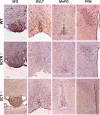An indispensable role of secretin in mediating the osmoregulatory functions of angiotensin II
- PMID: 20739612
- PMCID: PMC2992369
- DOI: 10.1096/fj.10-165399
An indispensable role of secretin in mediating the osmoregulatory functions of angiotensin II
Abstract
Fluid balance is critical to life and hence is tightly controlled in the body. Angiotensin II (ANGII), one of the most important components of this regulatory system, is recognized as a dipsogenic hormone that stimulates vasopressin (VP) expression and release. However, detailed mechanisms regarding how ANGII brings about these changes are not fully understood. In the present study, we show initially that the osmoregulatory functions of secretin (SCT) in the brain are similar to those of ANGII in mice and, more important, we discovered the role of SCT as the link between ANGII and its downstream effects. This was substantiated by the use of two knockout mice, SCTR(-/-) and SCT(-/-), in which we show the absence of an intact SCT/secretin receptor (SCTR) axis resulted in an abolishment or much reduced ANGII osmoregulatory functions. By immunohistochemical staining and in situ hybridization, the proteins and transcripts of SCT and its receptor are found in the paraventricular nucleus (PVN) and lamina terminalis. We propose that SCT produced in the circumventricular organs is transported and released in the PVN to stimulate vasopressin expression and release. In summary, our findings identify SCT and SCTR as novel elements of the ANGII osmoregulatory pathway in maintaining fluid balance in the body.
Figures





References
-
- MacGregor D. P., Murone C., Song K., Allen A. M., Paxinos G., Mendelsohn F. A. (1995) Angiotensin II receptor subtypes in the human central nervous system. Brain Res. 675, 231–240 - PubMed
-
- Wilson W. L., Roques B. P., Llorens-Cortes C., Speth R. C., Harding J. W., Wright J. W. (2005) Roles of brain angiotensins II and III in thirst and sodium appetite. Brain Res. 1060, 108–117 - PubMed
-
- Saavedra J. M. (1992) Brain and pituitary angiotensin. Endocr. Rev. 13, 329–380 - PubMed
-
- McKinley M. J., Mathai M. L., McAllen R. M., McClear R. C., Miselis R. R., Pennington G. L., Vivas L., Wade J. D., Oldfield B. J. (2004) Vasopressin secretion: osmotic and hormonal regulation by the lamina terminalis. J. Neuroendocrinol. 16, 340–347 - PubMed
-
- Ferguson A. V., Washburn D. L., Latchford K. J. (2001) Hormonal and neurotransmitter roles for angiotensin in the regulation of central autonomic function. Exp. Biol. Med. (Maywood) 226, 85–96 - PubMed
Publication types
MeSH terms
Substances
LinkOut - more resources
Full Text Sources
Other Literature Sources
Molecular Biology Databases

